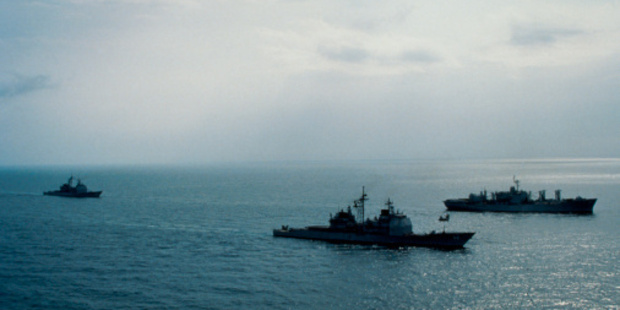
Three Chinese warships have sent dark new clouds scudding over Australia's strategic horizon, adding to growing unease across the region as Beijing flexes its muscles through the Indian Ocean to the western Pacific.
The sudden appearance near Australia of the guided missile destroyers Wuhan and Haikou, in company with the advanced, 20,000-tonne landing ship Changbaishan, led to the RAAF Orion patrol aircraft being scrambled and sent north of the continent.
Although operating legally in international waters, the unannounced passage of the ships through the Sunda Strait between Java and Sumatra to the Lombok Strait off Bali has been seen as a clear message that China is now a major maritime power operating wherever it wants to go.
The series of 10 exercises between Indonesia and Australia was also a demonstration of China's increasing might, reach and sophistication as the emerging superpower ramps up its territorial claims.
The implications have triggered concern also in India, Japan, Southeast Asia and the Philippines, and raised further questions about Beijing's increasing presence in the South Pacific - particularly its development and expansion of ports in Tonga and Papua New Guinea.
The United States has already responded with a shift in its naval emphasis to the region, increasing its marine presence in Australia and the intention to base 60 per cent of its warships in the Asia-Pacific region by 2020.
By that time China's navy will have become even more formidable. Funded by an economy that is now the world's second-largest and on track to become the biggest, Beijing's US$110 billion ($132 billion) defence budget is exceeded only by the US.
Its sole aircraft carrier, the Liaoning, bought from Ukraine and refurbished, will be joined by an 80,000-tonne nuclear-powered vessel within six years, with plans for four more. As well as a larger, advanced surface fleet, China's ballistic and attack submarine force will also be significantly expanded.
Chinese warships are rapidly gaining new potency through advanced technology. This month a Song class diesel-electric attack submarine slipped past screening US warships to surface within striking range of the aircraft carrier USS Kittyhawk. That set the alarm bells ringing.
In the Lombok Strait, the three Chinese warships conducted exercises including fast-response electronic warfare, anti-missile defence, and attack co-ordination.
State television said no advance warning of the mission had been given as "part of the navy's plan to simulate actual combat conditions".
Analysts have seen a number of signals in the deployment beyond the demonstration of power, reach and "self-confidence" advocated by policymakers in Beijing.
Among these is the ability to protect the sea lanes vital for its energy imports, and the potential to use alternatives to the Malacca Strait if the key route was closed.
The exercise was also the first to extend beyond the western waters of the Indian Ocean, and to come so close to Australia.
Last October, similar capabilities were demonstrated when Chinese warships, supported by bombers and patrol aircraft, passed through the Japanese archipelago to conduct war games in the western Pacific, alarming Japan.
With tensions already high over the disputed Senkakus/Diaoyu islands, Tokyo increased its defence budget, announcing plans for more strike jets, warships and other hardware.
India is also concerned at China's operations in the eastern Indian Ocean, worrying that Beijing is placing the crucial waters around the Andaman and Nicobar islands within reach of its military.
China insists that its naval operations present no threat to other countries in the region and that its Lombok Strait exercises were part of annual training plans during which its navy upheld its right to free passage in international waters.
China has also been increasing cooperation within the region, joining US warships for search-and-rescue exercises near Hawaii last year, and sending ships on goodwill visits to Australia and New Zealand. This year it will take part in the huge American Rimpac naval exercise off Hawaii.
Prime Minister John Key has said New Zealand "doesn't feel concerned by anything [China] might be doing", a view also expressed after the Lombok exercises by Australian Foreign Minister Julie Bishop.
Noting that the exercises took place in international waters, Bishop said: "The Chinese navy is growing, commensurate with the increase in size and strength of the Chinese economy and its place in the region and its place in the globe."
Lowy Institute international security programme director Rory Medcalf wrote that there was nothing illegal or fundamentally hostile in the exercises, and that a greater Chinese role in the Indian Ocean was inevitable.